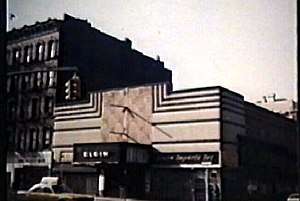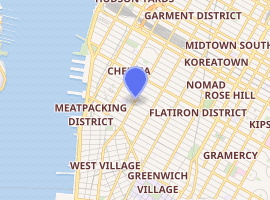Elgin Theater
The Elgin Theater is the former name of the building now known as the Joyce Theater, located on the corner of 19th Street and Eighth Avenue in the Chelsea neighborhood of Manhattan in New York City. The theater showed films from its opening in 1942 until 1978. Its longtime manager, Ben Barenholtz, invented midnight movie programming for the theater. Following a gut renovation, the building reopened in 1982 as the Joyce Theater, a 472-seat dance theater.
 The Elgin Theater, before 1982 | |

| |
| Address | 175 Eighth Avenue |
|---|---|
| Location | Chelsea, New York City, United States |
| Coordinates | 40°44′34″N 74°00′02″W |
| Public transit | 14th St./Eighth Ave (NYC Subway) |
| Type | Theater |
| Genre(s) | Cinema |
| Capacity | 600 |
| Construction | |
| Built | 1941 |
| Opened | 1942 |
| Renovated | 1982 |
| Closed | 1978 |
| Architect | Simon Zelnik |
History
Theater programming until 1977
The theater opened in 1942. It was designed in the Art Moderne style by Simon Zelnik[1] and had seating for 600.
The Elgin opened as a first-run cinema. In the 1950s through 1965 it presented Spanish-language cinema.[2][3]
In 1968, Ben Barenholtz assumed management of the theater and converted it to a repertory and art film house. The Elgin soon became noted for the innovation and variety of its programming, which ranged from revivals of classic Hollywood films; experimental works by Jonas Mekas, Kenneth Anger, and Andy Warhol; and films by then-emerging directors such as Jonathan Demme and Martin Scorsese.[4] Around 1975, Steve Gould and Chuck Zlatkin took over management of the theater in partnership with Barenholtz and continued similar programming.[5]
With the midnight screening of Alejandro Jodorowsky's surrealist western El Topo on December 18, 1970, the Elgin became the first theater to show midnight movies.[6] Barenholtz recalled, "I was told by the experts: 'Who's going to come see a film at midnight? You're out of your mind.' But within two years, there wasn't a city in the country that didn't have a midnight movie going."[7] El Topo premiered at The Elgin on December 17, 1970 and ran continuously seven days a week until the end of June 1971.[8] Author Gary Lachman claims that the film Invocation of My Demon Brother (1969) "inaugurat[ed] the midnight movie cult at the theater."[9][10]
The theater was part of an efflorescence of revival cinema in New York City during this period. The New York Times' film critic Vincent Canby observed, "There is a heaven for movie buffs and it could be here and now thanks to The Elgin, The Thalia, The Symphony and all those other houses that occasionally recall the past."[11]
In May 1977, while continuing to present film, the theater began to mount programs of rock music and allied acts. These two-set evenings were produced by Bleu Ocean. There were local objections to noise from the concerts.[12]
Gay pornography controversy
On March 20, 1977, Roger Euster, the owner of the Elgin, evicted his tenants, Gould and Zlatkin, for non-payment of rent totaling $21,393. He immediately signed a lease with Tel-a-Gay, a producer and exhibitor of gay films, who launched an all-gay-pornography program on March 21.[13] The change inspired immediate protests by local citizens groups and picketing in front of the theater. The theater shut its doors the following day. Later that week, Euster and Tel-a-Gay President William Perry met with the community groups. They agreed to return the theater to its previous programming format on a trial basis to see if the operation could be sustained on the income.[14]
Conversion to a dance theater
By late 1978, the theater had stopped showing films and was for sale. It was purchased in early 1979 by the Eliot Feld Ballet with the intention of converting it to a theater for smaller dance companies.[15] The building reopened in 1982 as the 472-seat Joyce Theater. Philanthropist LuEsther Mertz underwrote the purchase of the theater in 1979, at a cost of $225,000. The renovated facility was named for her daughter, Joyce, to honor this contribution.[16]
See also
- 1942 in architecture
- List of theaters in New York
References
- Notes
- White, Norval; Willensky, Elliot (June 2000). AIA Guide to New York City (4th ed.). New York City: Three Rivers Press. p. 182. ISBN 0-8129-3107-6.
- Davis, Ben; Owners of the Elgin. "Children of the Sixties: An Interview with the Owners of the Elgin". Film Quarterly. 53 (4): 4. JSTOR 1213747.
- Zoloto, Sam. "Inge's 'Birth Day' to Open in March/Theaters Change Hands". The New York Times (31 Dec 1965). p. 12. Retrieved June 28, 2020.
- Peter, Belsito (October 8, 2013). "Ben Barenholtz: A Life in Film". Indie Wire. Retrieved September 22, 2017.
- Davis, Ben; Owners of the Elgin. "Children of the Sixties: An Interview with the Owners of the Elgin". Film Quarterly. 53 (4): 4. JSTOR 1213747.
- Sandomir, Richard (July 5, 2019). "Ben Barenholtz, Midnight-Movie Innovator, Is Dead at 83". The New York Times.
- "It Must Be Midnight And Must Be Weird". New York Times. Retrieved September 22, 2017.
- Hoberman, J.; Rosenbaum, Jonathan (1991). Midnight movies. New York, N.Y.: Da Capo Press. p. 93. ISBN 9780306804335.
- Brottman, M.; Rowe, C.; Powell, A. (2002). Jack Hunter (ed.). Moonchild: The films of Kenneth Anger. London: Creation Books. p. 112.
- Lachman, Gary (2001). Turn Off Your Mind: The Mystic Sixties and the Dark Side of the Age of Aquarius (New York: Disinformation). ISBN 0-88064-278-5, p. 305.
- Vincent Canby (April 12, 1970). "Is Busby Really Camp". New York Times. Retrieved September 21, 2017.
- Nusser, Dick. "Queens House Books Rock Every Weekend". Billboard (June 18, 1977): 36. Retrieved September 22, 2017.
- "Neighbors Assail Elgin's Switch to Homosexual Films". New York Times. Retrieved September 21, 2017.
- "Elgin Cancels Homosexual Films After Chelsea Residents Protest". New York Times. Retrieved September 21, 2017.
- "Dance: Eliot Feld Ballet Acquires Elgin Theater in Chelsea". New York Times. Retrieved September 21, 2017.
- "Creating a Theater Just for Dance". New York Times. Retrieved September 21, 2017.